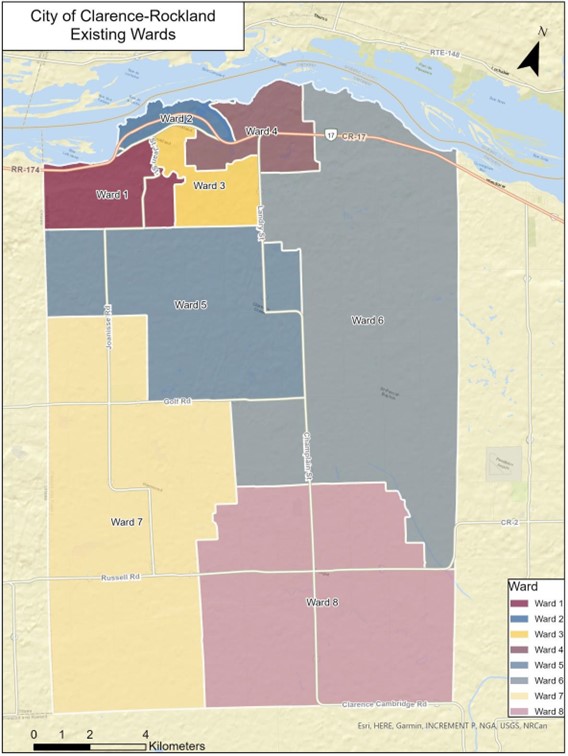Ward Boundary Review

How well do you know Clarence-Rockland?

Preliminary Options Report
 The City of Clarence-Rockland has hired Watson & Associates Economists Ltd. and Dr. Robert J. Williams, known as the Consultant Team, to do a thorough and independent review of the ward boundaries. The main goal of this study is to help City Council decide whether to keep the current ward system or change it.
The City of Clarence-Rockland has hired Watson & Associates Economists Ltd. and Dr. Robert J. Williams, known as the Consultant Team, to do a thorough and independent review of the ward boundaries. The main goal of this study is to help City Council decide whether to keep the current ward system or change it.
Some key questions to consider are:
- Should Council consider dissolving the wards to elect all councillors at-large (in what the Municipal Act calls a “general vote” system)?
- Should Council consider changing the size or election method of Council (council composition)?
- If the ward system is maintained, what guiding principles will be observed when designing the wards?
This review is based on the idea that everyone in Clarence-Rockland should have fair and effective representation on election day and throughout the Council's term. It should reflect how people and communities are spread out in the city today.
Setting
The City of Clarence-Rockland was formed on January 1, 1998, following a Ministerial Order from March 27, 1997. This order combined the former Town of Rockland and the Township of Clarence into one new municipality called the City of Clarence-Rockland. The Police Village of Bourget was also dissolved as part of this change.
The City is one of eight lower-tier municipalities in the United Counties of Prescott and Russell. The Ministerial Order stated that the new City Council would have nine members: one Mayor and eight councillors. The Mayor is elected by all residents, while the eight councillors are elected from eight different wards, with one councillor per ward. The ward boundaries were set in 1997 and have not been changed since.
Click here for the Ward Boundary Map to find existing ward configurations for Clarence-Rockland.
| Public Consultations | ||||||||||||||||||||||||||||||||||||||||||||||||||||||||||||||||||||||||||||||||||||||||||||||||||||||||||||||||||||||||||||||
|
April 29, 20254:00 pm - 5:30 pm Conference room - Bourget Fire Hall 2130 Laval Street, Bourget
6:30 - 8:00 Conference room - Rockland Fire Hall 1550 Laval Street, Rockland |
||||||||||||||||||||||||||||||||||||||||||||||||||||||||||||||||||||||||||||||||||||||||||||||||||||||||||||||||||||||||||||||
| Maps of Proposed Options | ||||||||||||||||||||||||||||||||||||||||||||||||||||||||||||||||||||||||||||||||||||||||||||||||||||||||||||||||||||||||||||||
Existing Wards
Option 1A
Option 1B
Option 2
Option 3
Option 4
Option 5
|
||||||||||||||||||||||||||||||||||||||||||||||||||||||||||||||||||||||||||||||||||||||||||||||||||||||||||||||||||||||||||||||
| What is the Optimal Size for a Municipal Council? | ||||||||||||||||||||||||||||||||||||||||||||||||||||||||||||||||||||||||||||||||||||||||||||||||||||||||||||||||||||||||||||||
|
The Municipal Act, 2001 only says that a city council must have at least five members, including one Mayor who is elected by everyone. There are no references to a maximum or to an “appropriate” size associated with, for example, the population of the municipality. This absence contrasts with the provisions of regulations issued under the Education Act (Ontario Regulation 412/00) which include a detailed formula to determine both the number of trustees and their distribution across each school board’s area of jurisdiction before each regular municipal election. As a result, the composition of local councils in Ontario varies widely. Clarence-Rockland's council has nine members, which is four more than the minimum. When compared to other cities in Ontario, Clarence-Rockland's council is the same size or larger than some bigger cities like Vaughan, Waterloo, Kawartha Lakes, and Belleville. However, it's smaller than some rural or smaller cities like North Perth and Muskoka Lakes. Table Bi compares Clarence-Rockland’s council composition to the other municipalities in Prescott and Russell and Figure Bii compares Clarence Rockland’s council composition to selected municipalities in Ontario in the same population range.
Source: Statistics Canada. *Includes each Head of Council and the Deputy Mayor in East Hawkesbury.
Source: Statistics Canada. *Includes each Head of Council and the Deputy Mayor in Essa, Tecumseh, Strathroy-Caradoc, Wasaga Beach and Collingwood. Legislative AuthorityThe Municipal Act, 2001 gives the City Council the power to decide how many councillors there should be (Section 217). This is separate from how they are elected (Section 222). A key question for Clarence-Rockland is whether a nine-member council is the right size to govern a city of about 26,000 people, with more growth expected in the next decade. Factors To ConsiderThe best size for a council depends on what it needs to do and how well it can do it. Here are three important factors: 1. Effective Political Management
2. Responsiveness
3. Accountability
ConclusionTo decide the best size for Clarence-Rockland's council, we need to think about how well it can manage the city, how responsive it can be to residents, and how accountable it is to the public. These factors will help us understand if nine councillors are the right number or if a different size might work better. |
||||||||||||||||||||||||||||||||||||||||||||||||||||||||||||||||||||||||||||||||||||||||||||||||||||||||||||||||||||||||||||||
| The Component Parts of the Clarence-Rockland Council | ||||||||||||||||||||||||||||||||||||||||||||||||||||||||||||||||||||||||||||||||||||||||||||||||||||||||||||||||||||||||||||||
|
The Mayor: The Municipal Act, 2001 no longer specifically uses the term "mayor." Instead, it uses the term "head of council." ** The position itself is formally included in many upper-tier governance arrangements such as in the United Counties of Prescott and Russell where the Mayors of the eight area municipalities sit on the County’s governing body. This means that the Mayor of Clarence-Rockland – but no other member of Clarence-Rockland Council - participates in both the County and local Councils. Ward Councillors*** : The second component of Clarence-Rockland Council consists of the eight City Councillors, individuals who are presently selected by the votes cast by the City’s electors in eight separate ward elections. In other words, Councillors do not compete against one another in an election but the candidate who receives the most votes in the individual ward becomes the councillor. This method of determining the winner is sometimes called a “first past the post” system: whoever has the most votes when all ballots are counted (that is, whoever gets to the “finish line” ahead of all other candidates) is declared the winner. It's also known as a "plurality" system because the winner just needs more votes than any other single candidate. The City Council has the power to change the number of Councillors and how they are elected. Here are some options being considered in this Discussion Paper: An elected Deputy-Mayor: The Municipal Act, 2001 doesn't specifically mention the position of Deputy Mayor, but many counties in Ontario do have this role. However, the United Counties of Prescott and Russell, where Clarence-Rockland is located, do not include a Deputy Mayor on their County Council. This means that a Deputy Mayor in Clarence-Rockland would focus on local duties, such as chairing committee meetings or stepping in when the Mayor is absent. Currently, Clarence-Rockland doesn't have a designated Deputy Mayor. Instead, each of the eight ward councillors takes turns serving as Deputy Mayor for six months during the four-year council term. This ensures that all councillors get a chance to take on the role. In other cases (and as set out for consideration by the Consultant Team), the position of deputy mayor is open to any qualified elector who files a nomination paper to run specifically for the office and the position is filled based on the votes cast on a separate ballot in a “general vote” (at-large) system. If the community supports the idea of an elected Deputy Mayor, both options are possible under the Municipal Act. The goal is to start a discussion about whether Clarence-Rockland should have an elected Deputy Mayor and what that role should look like. The Consultant Team has helped other cities make similar changes, so they are well-equipped to guide this process, even if no changes are ultimately made. A completely new [ward] structure: As noted above, the directions the Consultant Team also included providing “options for the realignment of the existing eight (8) wards or provide options for a completely new ward structure which may or may not affect the composition of council.” Here are a few possibilities: 1. Re-dividing the Existing Wards: The simplest option is to redraw the boundaries of the current eight single-member wards. This is the focus of the Consultant Team. 2. Multi-Member Wards: Another option is to create wards where more than one councillor is elected. This can give residents more local contacts, but it also means larger wards and more residents for each councillor to represent. Given Clarence-Rockland's size and history, this might not be the best fit. While some council members have discussed this idea, it's not a common practice in Ontario and could add confusion and reduce accountability. 3. General Vote System: This option involves having no wards at all. Instead, all councillors would be elected by the entire city in a "general vote" system. The advantage is that it can reflect community-wide interests and give voters more choices. However, it might also lead to under-representation of specific Watson & Associates Economists Ltd. PAGE 3 WBR Paper C: Components neighborhoods and viewpoints. Each councillor would have to represent about 29,000 residents, which could make them less accessible to some parts of the city If the public shows interest in these alternatives during the initial consultation, the Consultant Team will advise the Council and seek direction on whether to include them in the ward boundary review. The goal is to find a system that works best for the community. In the preliminary assessment of the Consultant Team, Clarence-Rockland is better served by having councillors elected in single-member wards. * Ontario Municipal Act, 2001, s. 217 (1) 3 ** The term “mayor” is still used in the City of Toronto Act and in the title of Bill 3 (Strong Mayors, Building Homes Act, 2022) *** The term “ward councillor” is used here since that is the present designation. Provincial legislation authorizes a council to “dissolve’” the wards, as will be discussed below. |
||||||||||||||||||||||||||||||||||||||||||||||||||||||||||||||||||||||||||||||||||||||||||||||||||||||||||||||||||||||||||||||
| Guiding Principles to Design Wards | ||||||||||||||||||||||||||||||||||||||||||||||||||||||||||||||||||||||||||||||||||||||||||||||||||||||||||||||||||||||||||||||
|
There are no standard practices, rules, or principles in the laws or regulations to help with this. However, we can look at what other cities in Ontario have done successfully and at past decisions from the Ontario Municipal Board (now called the Ontario Land Tribunal) for some ideas. But the main focus should be on what works best for Clarence-Rockland and its goals. Considerations for Clarence-RocklandIt is not clear what factors were considered when the ward boundaries were set in 1997. But for this review, we have four well-established principles to guide us in creating a fair system of representation for the city. The list includes: 1. Representation by populationIt's important that each ward has about the same number of people. This way, everyone's voice is heard equally, and councillors have a similar workload. However, some variation is okay because different areas have different population densities. For Clarence-Rockland, a difference of up to 25% from the average ward population is acceptable. This will be referred to as “the population parity” principle. 2. Communities of interest and neighbourhoodsWe should try to keep existing communities and neighborhoods together within a single ward. This helps maintain strong local connections and ensures that the unique needs of each area are represented. For example, the rural area should ideally be in one ward. This will be referred to as “the communities of interest” principle. 3. Present and future population trendsWhen designing wards, we need to think about how the population will grow over the next 12 years (three election cycles). This helps ensure that the wards remain fair and balanced in terms of population over time. We'll use data from the Census, building permits, and development plans and local forecasts to make these predictions. This will be referred to as “the population trends” principle. 4. Physical features as natural boundariesWard boundaries should use natural and human-made features like rivers, roads, and railway lines. These features often already divide communities and can make it easier for councillors to represent their residents. The boundaries should be simple and easy to understand, with straight lines and few turns. This will be referred to as “the natural boundaries” principle. Effective RepresentationWhat is understated in the terms of reference is a fifth “well established” principle, although its importance is understood: The most important principle is ensuring that the ward system provides effective representation. This means that the system should work well for all residents and that their needs are fairly considered. Sometimes, this might mean prioritizing other principles, like keeping communities together, over having exactly equal populations in each ward. In contrast to the first four guiding principles, effective representation should be seen as an outcome of the application of the other four principles rather than a precondition for the design of a viable ward system. Overview: No ward design will perfectly meet all these principles, but the best designs will come as close as possible. If we need to deviate from one principle, it should be to better support effective representation. |
||||||||||||||||||||||||||||||||||||||||||||||||||||||||||||||||||||||||||||||||||||||||||||||||||||||||||||||||||||||||||||||
| Is a Ward Boundary Review Necessary? | ||||||||||||||||||||||||||||||||||||||||||||||||||||||||||||||||||||||||||||||||||||||||||||||||||||||||||||||||||||||||||||||
Objective of a Ward Boundary ReviewThe goal of a Ward Boundary Review is to look closely at Clarence-Rockland's electoral system to make sure it provides fair and effective representation for all residents. Even though many people support reviewing the wards, we still need to evaluate the current map to see what needs to change and what can stay the same. Current Ward DesignClarence-Rockland's current ward design was created in 1997 when the population was about 19,610. Today, the population has grown to over 26,500 (2021 census), and it is expected to increase to more than 30,000 by 2031. As the community changes, so should the way we elect our representatives, especially if there are noticeable and unfair differences in the population of the existing wards. Evaluating the Current WardsA key part of the review is to check how well the current wards meet the guiding principles for a fair and effective ward system. These principles include:
We will apply these principles to the current ward design to identify its strengths and weaknesses, just as we would for any new design. This helps us understand what changes are needed to make the system better. Preliminary Insights into the Clarence-Rockland Ward SystemBefore we come up with new ideas for the ward boundaries, it makes sense to determine whether the current system still works well. That is, does it provide fair and effective representation. If it meets these principles, we won't need to make any changes. You can see the current ward boundaries in Figure Ei Ei
Representation by Population (Population Parity): One of the main goals of this review is to create a system where each ward has a similar number of people, with some small differences allowed to reflect the way people are spread out across the city. The best way to measure success is to see how close each ward is to the ideal size. Understanding Optimal Ward SizeIn a system where each ward elects the same number of councillors, the ideal size is the middle point. Here's how we define it:
The 25% variation is a common standard used in cities like Clarence-Rockland, which have areas with different population densities, rural areas, and planned new developments. Current Ward ConfigurationWhen the current ward boundaries were set, the city's population was about 19,610. This means the ideal population for each ward was 2,451, with an acceptable range between 1,838 and 3,064 people. Population data for 2021 (see Figure Eii) indicates that the optimal population for a ward in Clarence-Rockland is now 3,313, with an acceptable range between 2,485 and 4,141. Only two wards fall within the “optimal” range, but three wards fall “outside the range” and three wards are within the acceptable range “below/above optimal”. Looked at another way, the same imbalance is reflected in the divergence in population between the largest and smallest wards (from 4,673 in 2021 to 2,209) a difference of close to 2,500 residents.
Source: Statistics Canada 2021 Census – DB Level Data compiled by Watson & Associates Economists Ltd.
A ward system composed of these wards does not meet the representation by population principle as we have defined it since three wards fall outside the optimal range of variation. Communities of interest: In Canada, electoral districts aren't just about dividing the population evenly to make sure everyone's vote has roughly the same influence in an election outcome. They also take into account other important factors, like "community of interest" and are part of a system “which gives due weight to voter parity but admits other considerations where necessary.”2 This means that districts should be made up of people who share common interests and connections, such as living in the same neighborhood or community. Community of Interest in Clarence-RocklandClarence-Rockland has distinct communities with their own unique interests. This is one of the reasons why a ward system still makes sense for the city. However, the current wards don't meet the population balance requirements very well. So, we need to ask: Are the current wards still a good way to represent the community if we focus more on these shared interests? While the current wards may not have a similar number of people, they might still work if they keep communities together and reflect the interests of the residents. We need to look at both population balance and community interests to decide whether changes are needed. Overall, the eight wards in Clarence-Rockland do a good job of keeping communities with common interests together.
The wards generally keep people together who live in similar communities and share common interests. One consequence of this pattern, however, is the widespread impression that the wards preserve the historic differences between the urban and rural parts of the City (that is, the former Town of Rockland and the Township of Clarence) Population Trends: When reviewing ward boundaries, we look at future population trends to make sure the ward structure works well beyond the 2026 municipal election. Future population growth in Clarence-Rockland over the next decade will be concentrated the urban settlement area or adjacent to it; two of the four wards in that part of the City are already well above the optimal point. Conversely, all four wards in the rural part of the City are below the optimal point. However, since very little growth is anticipated in Wards 5, 6 and 7, there is every expectation that the wards will continue to be unbalanced by 2034. The current setup will not correct this pattern and might even make it worse. In other words, the current ward boundaries will not meet the population growth principle.
Effective Representation: The most important principle is "effective representation," which the Supreme Court of Canada identified in the Carter decision. This means that ideally everyone's vote should count equally, so that each person's voice is heard fairly in government decisions. The Supreme Court noted that relative parity of voting power was a prime, but not an exclusive, condition of effective representation since other factors – such as those summarized above – contribute to the achievement of effective representation. The limitations discussed above hinder the achievement of effective representation in the present ward configuration in Clarence-Rockland. OverviewIn Clarence-Rockland, the number of people each councillor represents varies significantly, with some councillors having almost twice as many constituents as others. This makes it difficult for everyone to have comparable access to their council representative. The current ward boundaries also cause some residents to count less than others in council decision-making; the vote of a councillor representing over four thousand residents is equal to a vote cast by the representative of just over two thousand people. As the population grows, these differences will become even more pronounced, further undermining fair representation. While no ward design can perfectly meet all principles, the best designs aim to follow them as closely as possible, especially in ensuring equal representation. Other factors can sometimes justify deviations, but they should still support fair representation. Our initial preliminary assessment indicates that Clarence-Rockland needs a ward boundary review to ensure that everyone's vote counts equally, and that each councillor represents a similar number of people. The current ward boundaries in both urban and rural areas are not as clear and straightforward as they could be.
[1] The degree to which each guiding principle is satisfied is ranked as “Yes” (fully satisfied), “Largely Successful,” “Partially Successful,” or “No” (not satisfied).
|
| For more information |
|
Monique Ouellet, Clerk 613-446-6022 ext. 2300 |

.png)
 Have your say in shaping the future of your community! Participate in the public consultation on ward boundary reviews and help us ensure fair and effective representation for all.
Have your say in shaping the future of your community! Participate in the public consultation on ward boundary reviews and help us ensure fair and effective representation for all.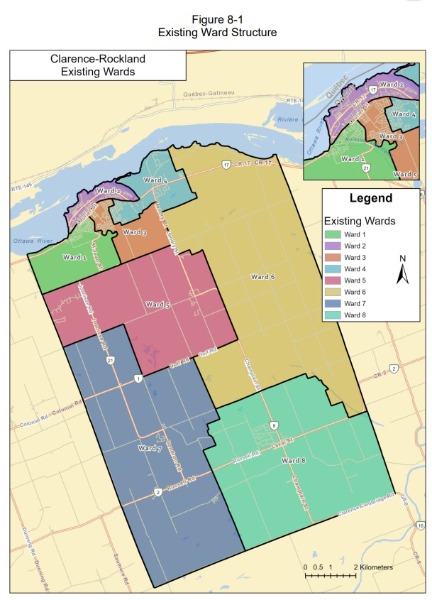
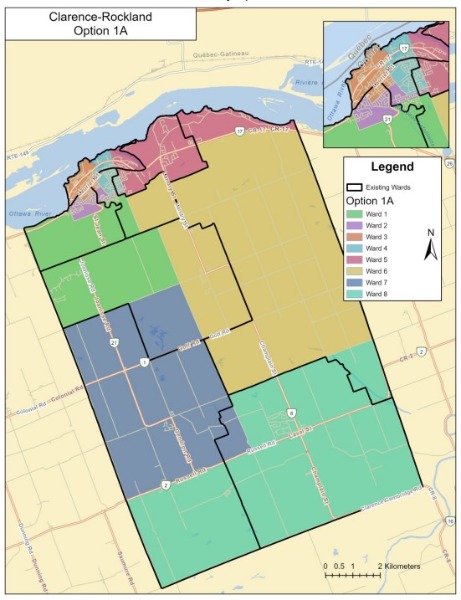
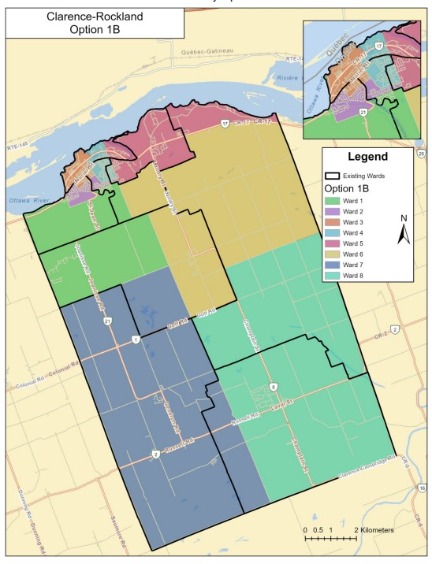
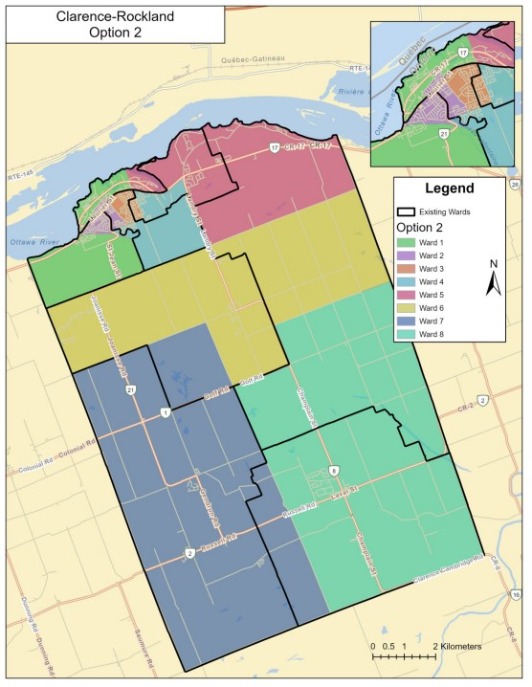
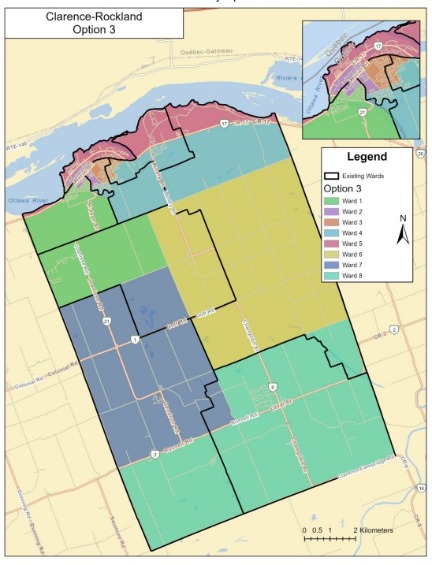
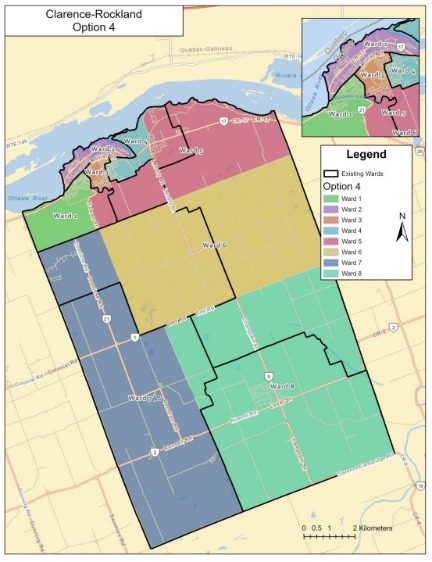
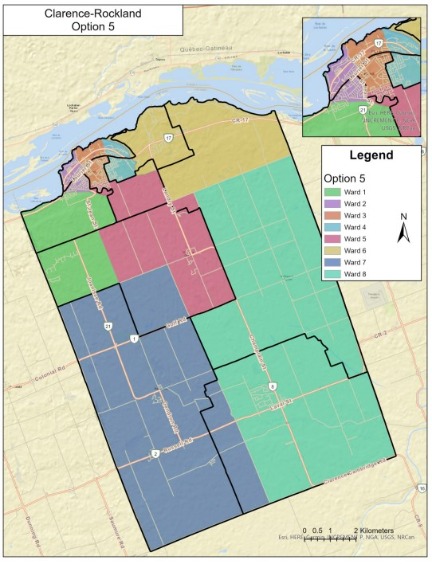
 In Ontario, there are no clear rules or formulas for deciding how many councillors a city should have. Each city has its own history and traditions, and there's no set time to review the number of councillors.
In Ontario, there are no clear rules or formulas for deciding how many councillors a city should have. Each city has its own history and traditions, and there's no set time to review the number of councillors. Nine people serve on Clarence-Rockland Council: a mayor (“head of council”) and eight Councillors. The office of mayor and the way that person is elected are not open to modification in this review since under Provincial legislation there must be a “head of council” elected by general vote. * However, the remainder of the Council can be reconstituted should the community and Council see value in changing the status quo.
Nine people serve on Clarence-Rockland Council: a mayor (“head of council”) and eight Councillors. The office of mayor and the way that person is elected are not open to modification in this review since under Provincial legislation there must be a “head of council” elected by general vote. * However, the remainder of the Council can be reconstituted should the community and Council see value in changing the status quo. This paper talks about the important things to consider when designing wards to ensure fair and effective representation for Clarence-Rockland residents. The provincial laws do not provide specific guidelines for what a city should consider when setting up or changing its ward system.
This paper talks about the important things to consider when designing wards to ensure fair and effective representation for Clarence-Rockland residents. The provincial laws do not provide specific guidelines for what a city should consider when setting up or changing its ward system.